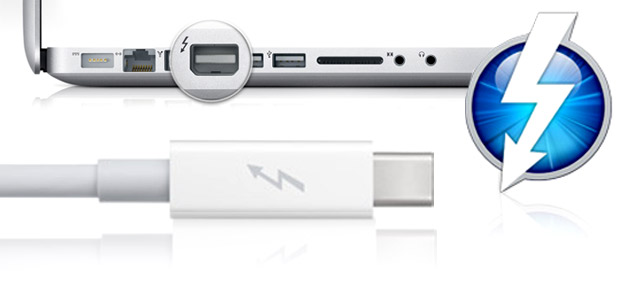It seems that right now thunderbolt and USB Type-C connectors are all over the electronics industry and seem to becoming the connector of choice for many PC & Tablet Manufacturers.
As first reported in thunderbolttechnology.net Optical cables for Thunderbolt ports that enable faster data transfers over longer distances on computers such as Apple’s Macintosh will be available later this year according to a report from Intel.
Thunderbolt was co-developed by Apple and Intel and is considered a faster alternative to USB 3.0, with transfer speeds
of up to 10Gbps (gigabits per second). A full-length, high-definition movie can be transferred from an external storage device to a laptop in less than 30 seconds.
The technology was introduced in 2009 with the promise of using pulses of light to transfer data. But because of the prohibitive cost of fiber optics, the first Thunderbolt installs on Apple’s Macintosh computers last year came with copper cables. According to http://www.digitimes.com/news/a20120316PD210.html PC makers like Lenovo are due to offer Thunderbolt ports in Windows laptops later this year.
The upside to optical is that it allows for longer cable runs, and as the technology develops, more bandwidth. But when connected via optical cables, devices that need power also require their own power supply. Running power over longer optical cable runs may not be practical due to impedance-induced power drop.
Copper has the advantage of providing up to 10 watts of power, which saves a device from requiring a power outlet.
Existing Thunderbolt ports on Apple’s Mac computers will be compatible with the upcoming optical cables. Users will be able to buy existing products and switch from copper to optical without changes in computers. Circuitry ensures that the Thunderbolt cables are transparent to copper or fiber optics connections.
But just over a year after its introduction, Thunderbolt is still maturing as the technology finds adoption on peripherals and computers. Intel is also taking steps to improve the technology.
In other reports Intel earlier this week said it was building support in Thunderbolt for PCI-Express 3.0 protocol, which would boost data transfer speeds.
I think these are exciting times as so many bets are being made on who will adopt the next dominant technology for PC’s & Tablets. One this that’s for sure is it looks like cables are here to stay for the foreseeable future.


